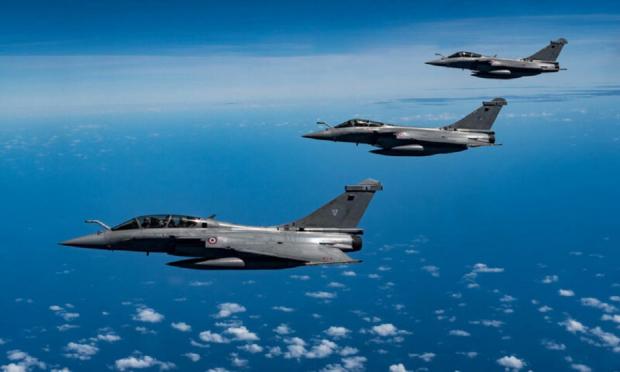It is a fact that Greece-France relations are currently at their peak, especially after the Strategic alliance signed between the 2 countries, which foresees the joint response to any aggressive act challenging the National sovereignty, at the expense of one of the two from a third country and after the purchase of French RAFALE fighter aircraft and BELHARA frigates from our country.
After all, since 1974 Greece has created, together with France, a framework of friendship-alliance, epitomized by the infamous slogan "Greece-France-Alliance" during the Prime Ministership of Konos Karamanlis, while since 20025 Greece belongs to the countries of Francophonie.
France is one of the 5 Permanent members of the Security Council and the only nuclear power of the EU, while its desire is to lead it by creating a European security pillar, on the model of NATO.
According to a reputable French defense media outlet, "the Ministry of the Armed Forces has started work on the development of the Rafale F5", noting:
French targets for RAFALE up to 2030
"The report attached to the draft Military Planning Act (LPM) 2024-30 states that the Air and Space Force (AAE) will have 137 Rafale fighter-bombers by 2030, while 185 were expected to be in stock by that time.
However, the final "goal" is expected to be reached in 2035 if there is no change by then. The Chief of Staff of the Air and Space Force (CEMAAE), General Stéphane Mille, stated that there will be an adjustment regarding the above schedule.
“By 2030, nearly sixty Rafales should be delivered, while during the LPM 2024-30 period, forty-five Rafales will be delivered. However, seventeen Rafales will be taken from the existing stock for export needs, here I am talking about the rest of the deliveries to Greece and Croatia.
The transition to "all-Rafale" by 2035 will clearly begin, with a confirmed target of 185 fighters," General Mille recalled, during a hearing in the National Assembly.
"For the Rafales, there are specifically the TALIOS pods (long-range identification and targeting system) and the AESA radars. We have a small amount of them, but the LPM project takes us from 25 to about 75 AESA at the end of the period. We will also have from 2026, 51 Talios pods,” CEMAAE explained.
“During our missions in Iraq and Syria, we realized that the Talios pod made it possible to provide information. It wasn't the heart of the mission, but we watched and learned things," CEMAAE revealed. Also, he continued, "this is all happening as we go along" and "the LPM project anticipates a larger volume of pods than we originally imagined."
Be that as it may, the AAE "Rafale" fleet will gather devices of different versions. If the F4.1, which is the first collective combat standard, has recently been certified by the Directorate General of Armaments (DGA), the F4.2 and F4.3 should soon follow. As are the F5s.
The prototype French fighter RAFALE F5
Indeed, General Mille told MPs that the Minister of the Armed Forces, Sebastion Lecornu, had recently "validated the start of development work on the F5 standard", i.e. "the one of the next decade", adding that:
“This work will be done under this LPM. They will testify to the scalability of the Rafale, which we have been looking for for several decades."
The development of the Rafale F5 is particularly important to guarantee the effectiveness of the Strategic Air Forces (FAS) and the Nuclear Air Force until 2035.
This should have the necessary capabilities to operate in highly contested environments and will carry the ASN4G hypersonic missile, which is expected to succeed the current ASMP-A.
“The F5 standard will enable the Rafale to stay one step ahead of threats. With the proliferation of denial-of-access strategies, maintaining our ability to enter combat first is a challenge for the Air Force,” General Mille asserted.
And above all, it will allow the UAE to regain the Suppression of Enemy Air Defense (SEAD) capability, which it lost with the withdrawal of the AS-37 MARTEL missile and Jaguar fighter-bombers.
"The SEAD capability is central to our future operations as it will allow us to be much more comfortable in increasingly challenging environments as modern equipment diverges across the planet," CEMAAE said. .
“The F5 standard will enable all SEAD capabilities to exist, even if the first elements will be available in the developments coming from the F4 standard.
I also recall the imminent arrival of the FMAN-FMC missile, which will allow due to its speed to "penetrate" enemy air defenses.
As for the Rafale F5, we know it will be a "very different" aircraft, with, according to General Mille, the ability to process "huge volumes of data", which will require mostly fiber optic cabling.
In 2021, referring to the F5 model, General Frédéric Parisot, the AAE's number two, explained that "within fifteen years", the Rafale will be equipped with "an impressive number of capabilities, some of which we have not yet imagined". .
The participation and the benefits for Greece
From the above, we realize that our country will have multiple benefits if it participates in the French RAFALE F-5 fighter program, which in our estimation will be something similar to the American F-35.
Our participation will also mean preferential treatment for acquiring them in the future, know-how, development of our defense industry with the construction of any parts thereof, new jobs and further deepening of the excellent relations with France.
Finally, we point out that it is very positive for our country to continue relying for its defense on the US-France, PESCO, NATO, participating in their armament programs, while trying to develop the appropriate know-how and capabilities for the development of its own defense industry, in order for it to be able to manufacture future highly advanced weapon systems and means.



